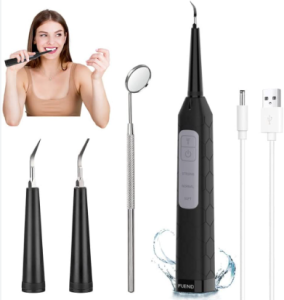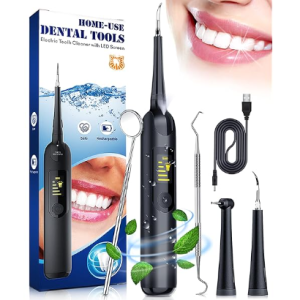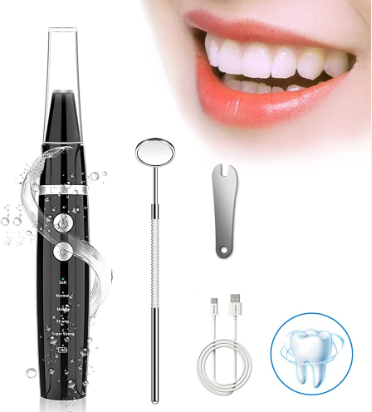Plaque Removal Tool
Maintaining good oral hygiene is essential for a healthy and confident smile. Plaque buildup can lead to various dental problems, including cavities, gum disease, and bad breath. While regular brushing and flossing are crucial, sometimes they may not be enough to effectively remove stubborn plaque. That’s where the best plaque removal tools come into play. In this comprehensive guide, we’ll explore the top plaque removal tools available in the market and help you choose the one that suits your needs best.
Electric Toothbrushes
Electric toothbrushes have revolutionized the way we clean our teeth. They are an excellent choice for plaque removal due to their efficiency in removing debris from the teeth and gumline. Here are a few reasons why electric toothbrushes are considered one of the best plaque removal tools:

Oscillating or rotating bristles: Electric toothbrushes come with bristles that move in a circular motion or rotate, ensuring thorough cleaning of teeth and gums.
Built-in timers: Many electric toothbrushes have timers that guide you on how long to brush each quadrant of your mouth, ensuring a consistent and comprehensive clean.
Pressure sensors: Some models have pressure sensors that alert you if you’re brushing too hard, helping to prevent gum damage.
Various brushing modes: Many electric toothbrushes offer multiple brushing modes, such as sensitive, whitening, and gum care, catering to different dental needs.
Brands like Oral-B and Sonicare are well-known for their high-quality electric toothbrushes that effectively remove plaque and improve oral health.
Water Flossers
Water flossers, also known as oral irrigators, use a stream of water to remove plaque and food particles between teeth and along the gumline. These devices are particularly beneficial for individuals with braces, dental implants, or sensitive gums. Here’s why water flossers are considered one of the best plaque removal tools:
Gentle yet effective: Water flossers provide a gentle yet thorough cleaning experience, making them suitable for those with sensitive gums.
Removes hard-to-reach debris: The pressurized water stream can dislodge plaque and debris from areas that may be challenging to reach with traditional floss.
Adjustable pressure settings: Most water flossers allow users to adjust the water pressure to their comfort level, ensuring a customized and comfortable experience.
Reservoir capacity: The larger the water reservoir, the longer you can floss without needing to refill it.
Popular brands like Waterpik offer a range of water flossers to cater to various needs and budgets.
Dental Picks and Interdental Brushes
Dental picks and interdental brushes are handheld tools designed to clean between teeth and in tight spaces where regular toothbrushes may struggle to reach. These tools are excellent for precise plaque removal. Here’s why they are among the best plaque removal tools:

Targeted cleaning: Dental picks and interdental brushes allow you to target specific areas, ensuring thorough removal of plaque and debris.
Variety of sizes: These tools come in various sizes to accommodate different interdental spaces and user preferences.
Portability: Dental picks and interdental brushes are compact and easy to carry, making them ideal for on-the-go plaque removal.
Reusable and eco-friendly: Most dental picks and interdental brushes are reusable, reducing waste compared to disposable floss picks.
Brands like GUM and DenTek offer a wide range of dental picks and interdental brushes to suit your needs.
Tongue Scrapers
Plaque can also accumulate on your tongue, leading to bad breath and affecting overall oral hygiene. Tongue scrapers are simple yet effective tools designed to remove bacteria and debris from the tongue’s surface. Here’s why tongue scrapers are considered essential for a complete plaque removal routine:
Improved breath: Tongue scraping can help reduce bad breath by removing odor-causing bacteria and debris.
Enhanced taste perception: A cleaner tongue allows taste buds to function optimally, enhancing your ability to taste and enjoy food.
Easy to use: Tongue scrapers are easy to use and maintain, requiring minimal effort for maximum benefits.
Hygienic: Most tongue scrapers are made of easy-to-clean materials, ensuring hygiene after each use.
Tongue scrapers are available from various brands and can be found in most oral care sections of drugstores or online retailers.
Dental Floss
While dental floss may be a traditional plaque removal tool, it remains one of the most effective ways to clean between teeth and along the gumline. Dental floss comes in various forms, including waxed, unwaxed, flavored, and dental tape. Here’s why dental floss continues to be a crucial tool for plaque removal:
Precision cleaning: Dental floss allows you to reach tight spaces between teeth, where plaque often accumulates.
Affordable and widely accessible: Dental floss is readily available, cost-effective, and an essential component of any oral care routine.
Variety of options: With different types of dental floss available, you can choose one that best suits your preferences and dental needs.
Popular dental floss brands like Oral-B, Colgate, and Glide offer a range of options to cater to individual preferences.
Choosing the Best Plaque Removal Tool: A Comprehensive Guide
Maintaining good oral hygiene is essential for overall health, and one of the key aspects of oral care is plaque removal. Plaque is a sticky film of bacteria that forms on your teeth and can lead to dental issues such as cavities and gum disease. To effectively remove plaque, you need the right tools. Here’s a comprehensive guide on how to choose the best plaque removal tool:
Consider Your Specific Needs:
Toothbrush: Start with a good quality toothbrush. Manual and electric toothbrushes are both effective, but some people find electric brushes easier to use.
Floss: Dental floss or dental tape is crucial for cleaning between teeth and removing plaque buildup in hard-to-reach areas.
Interdental Brushes: These tiny brushes come in various sizes to fit between teeth and remove plaque and food particles. They are excellent for those with larger gaps between teeth.
Water Flosser: A water flosser uses a stream of water to remove plaque and debris from between teeth and along the gumline. It’s a great option for people with braces.
Tongue Scraper: Don’t forget your tongue, as it can harbor bacteria. A tongue scraper can help remove plaque and bacteria from the tongue’s surface.
Seek Recommendations:
Consult your dentist or dental hygienist for recommendations tailored to your specific oral health needs.
Check for ADA Approval:
Look for products with the American Dental Association (ADA) Seal of Acceptance. This seal indicates that the product meets certain safety and efficacy standards.
Consider Ease of Use:
Choose tools that you are comfortable using consistently. An easy-to-use tool is more likely to be used regularly, leading to better results.
Evaluate Effectiveness:
Research and read reviews to find out how effective a product is at removing plaque. Look for evidence-based information.
Quality Matters:
Invest in high-quality tools from reputable brands. While they may be more expensive upfront, they tend to be more durable and effective in the long run.
Comfort and Accessibility:
Ensure that the tool you choose is comfortable to hold and easy to maneuver. Additionally, consider any special requirements you may have, such as ergonomic handles for those with arthritis.
Compatibility with Dental Work:
If you have dental work like braces, bridges, or dental implants, make sure the tools you select are compatible and won’t damage your dental work.
Budget Considerations:
While quality is essential, there are effective plaque removal tools available at various price points. Find a balance between quality and affordability that suits your budget.
Regular Maintenance:
Keep in mind that some tools may require replacement parts or maintenance. Factor in the cost and availability of these when making your decision.
Consult a Professional:
If you’re unsure which plaque removal tools are best for you, consult with a dental professional who can provide personalized recommendations based on your oral health.
Conclusion
Maintaining proper oral hygiene is vital for overall health and confidence, and effective plaque removal is at the core of it. The best plaque removal tools, including electric toothbrushes, water flossers, dental picks, tongue scrapers, and dental floss, offer a variety of options to suit different preferences and needs.
Selecting the right plaque removal tools depends on your unique dental requirements and personal preferences. For a comprehensive oral care routine, consider incorporating a combination of these tools to ensure that your teeth and gums remain healthy and free from plaque buildup. Regular visits to your dentist and dental hygienist are also essential to monitor your oral health and receive professional guidance on maintaining a plaque-free smile.
Investing in quality plaque removal tools and committing to a consistent oral care routine will not only contribute to a healthier smile but also boost your overall well-being and confidence. Remember that a healthy smile starts with effective plaque removal, so choose your tools wisely and smile with confidence!
FAQs about the best plaque removal tool
What is the best plaque removal tool for dental hygiene?
This question seeks recommendations for the most effective tool to remove plaque from teeth and gums, such as electric toothbrushes, dental floss, or water flossers.
Are electric toothbrushes better than manual ones for plaque removal?
This question explores the advantages and disadvantages of electric toothbrushes compared to
manual toothbrushes when it comes to removing plaque and maintaining oral health.
Can water flossers completely replace traditional dental floss for plaque removal?
This FAQ addresses the efficacy of water flossers in removing plaque and whether they can serve as a standalone replacement for traditional dental floss.
Which toothpaste or mouthwash is recommended for enhancing plaque removal?
This question delves into the role of toothpaste and mouthwash in plaque removal and seeks suggestions for products that are particularly effective in this regard.
How often should I use a plaque removal tool for optimal dental health?
This question aims to establish a recommended routine for using plaque removal tools to maintain good oral hygiene and prevent the buildup of plaque and tartar.
